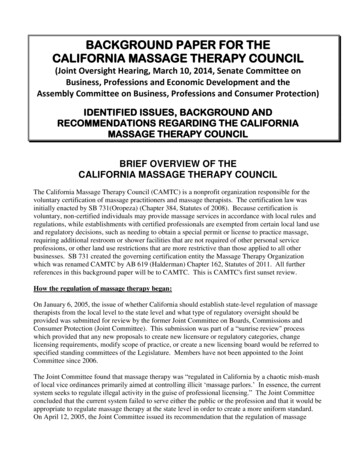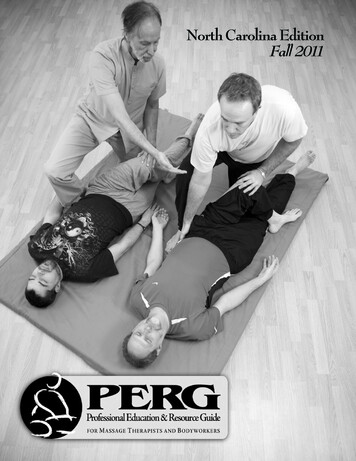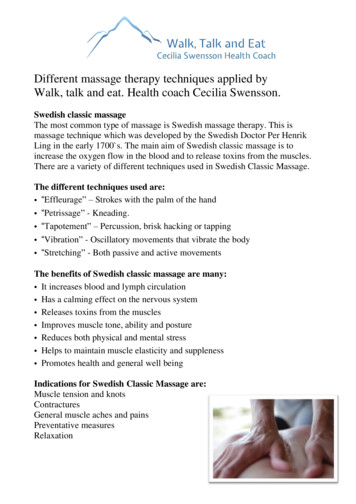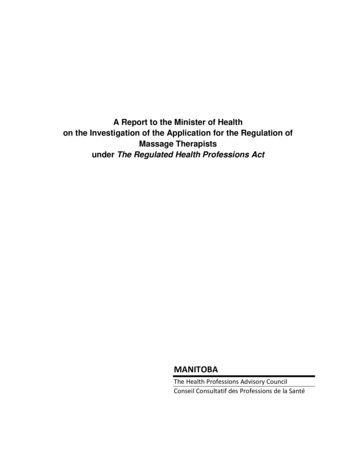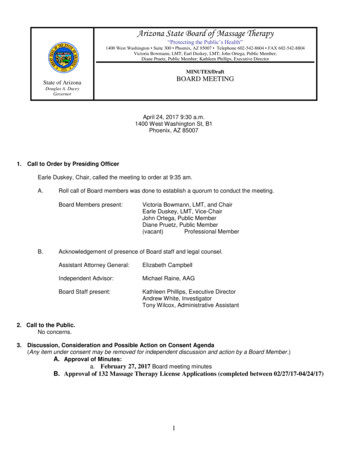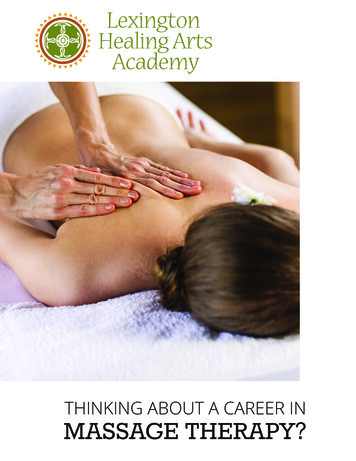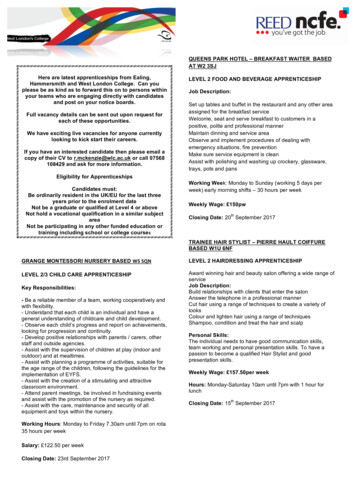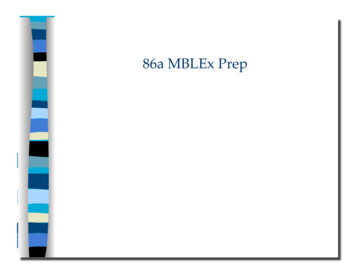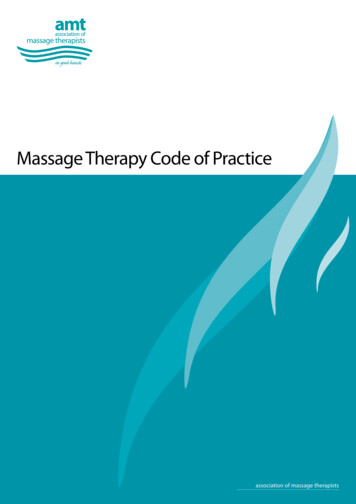
Transcription
Massage Therapy Code of Practiceassociation of massage therapists
ACKNOWLEDGEMENTSThis Code of Practice would not have come intobeing without the effort, commitment and energyof a number of people. Special acknowledgementis due to Rebecca Barnett, Tamsin Rossiter andDesley Scott who researched and wrote most of thestandards contained in this document.Sincere thanks and acknowledgement also go to: Alan Ford and Linda Hunter, who drafted three ofthe Standards in the Code Beth Wilson and Grant Davies(Office of the Health Services Commissioner,Victoria) and Professor Michael Ward (HealthQuality and Complaints Commission, Queensland)who provided invaluable feedback and insight Colin Rossie, whose research and contributionsto the Code of Practice Wiki helped to maximisestakeholder engagement in the process Annette Cassar and Jodee Shead,who assisted in the review process Linda White, Paul Lindsay and Katie Snell, whoproofed the document All those who took the time to read the draft Codeand provide feedback.Designed by Claudia IacovellaGraphic DesignerEmail: claudesign13@gmail.comM: 0417 073 383 Association of Massage Therapists LtdThis material is copyright Association of MassageTherapists Ltd (AMT). You may download, store incache, display, print and reproduce the material inunaltered form only (retaining this notice, or links toit where they appear) for non-commercial use or usewithin your organisation. You may not deal with thematerial in a manner that might mislead or deceiveany person.You may not reproduce this material withoutacknowledging AMT's authorship.Apart from any use as permitted under the CopyrightAct 1968, all other rights are reserved. Requests forfurther authorisation should be directed to:Association of Massage Therapists LtdPO Box 826Broadway NSW 2007P: 02 9211 2441E: info@amt.org.au
CONTENTSAcknowledgements2About AMT4Code of Ethics5Massage Therapy Code of Practice6Delivering quality care to Australian consumers6AMT Standard - Complaint Handling13AMT Standard - Professional Boundaries17AMT Standard - Draping21AMT Standard - Informed Consent24AMT Standard - Breast Massage28AMT Standard - Privacy and Confidentiality31AMT Standard - Record Keeping35AMT Standard - Issuing Receipts40AMT Standard - Advertising43AMT Standard - Infection Control and Hygiene47AMT Standard - Work Health and Safety51AMT Standard - Dry Needling57AMT Standard - Treatment of Minors61NOTES66
ABOUT AMTThe Association of Massage Therapists (AMT) is a national, not-for-profitassociation representing qualified Massage Therapists and Massage TherapyStudents. Established in 1966, AMT is the oldest association in Australia torepresent massage therapy in its own right and the premier representativebody for professional therapists.VisionAustralians have access to safe, ethical and evidence-informedmassage therapy treatment within the Australian health care system.Our mission is to: Support our membersProfessionalise practiceEducate and inform the public and other healthcare professionalsAMT valuesBest practiceParticipationLeadershipOpennessClient focusWe supportour membersto deliverevidence informed,skilled andethical careWe encourageour membersto connectand engage withcolleaguesWe haveset the agendafor industryadvocacysince 1966We strivefor thehighest standardsof transparencyand accountabilityWe put qualityand safety of careat the heart ofour agenda
code of ethicsAs a member of the Association of Massage Therapists, I commit myself to the highest standardsof practice:I will: care for the health, wellbeing and comfort of my clients with the utmost skill appropriate tomy current qualifications r espect the privacy, modesty and dignity of my clients and maintain appropriate professionalboundaries respect the beliefs, rights and values of my clients protect the confidentiality of my clients’ personal information refer clients to an appropriate therapist if their needs are outside my scope of practiceand training respect my fellow therapists in all disciplines c ommit myself to continuing professional development, sharing technical skills and raisingprofessional standards endeavour to enhance the reputation of the massage therapy profession s upport the Association of Massage Therapists in all its ideals, principles, codesand standards r efrain from conduct that adversely affects the reputation of the Association of MassageTherapists or the massage profession comply with the AMT Code of Practice and all applicable State, Territory and Federal laws
Massage Therapy Code of PracticeDelivering quality care to Australian consumers
IntroductionThe massage therapy standards contained in thisCode have been set down by the Associationof Massage Therapists Ltd (AMT) to provide aformal framework for the safe and ethical practiceof Massage Therapy in Australia, and to assistpractitioners in applying risk management policiesand procedures in their clinic or workplace.The Standards have been formalised to helppractitioners understand and meet theirprofessional duty of care. In the context of massagetherapy practice, duty of care pertains to themassage therapist’s ethical and legal obligation toavoid acts or omissions that are likely to causeharm to their clients. It is the appropriate andresponsible application of professional knowledge,skill and integrity.In the context of massage therapy practice,professional misconduct is defined as a violationof these ethical standards – a failure to meet or abreach of this Code of Practice. The Code clearly andcomprehensively sets out AMT’s position if calledupon to give Expert Witness evidence in court casesfor criminal negligence or assault.In developing this Code of Practice, AMT ishonouring its commitment to protect the public andserve its members, by promoting the safe and ethicalpractice of massage therapy. The Code should serveas a reference for: T herapists – to better understand their ethical,legal and professional obligations E ducators – to incorporate in the delivery ofHealth Training Package qualifications A llied health professionals – to assist inmaking appropriate health referrals D isciplinary bodies – to provide a benchmarkagainst which complaints can be assessed L egal authorities – to inform criminal and civilinvestigations and proceedings T he public – to empower clients toassess the quality of their care against anobjective framework.The Massage Therapy Code of Practice is a livingdocument that will evolve in line with changes inpractice and legislation.It is the massage therapist’s responsibility toformulate a risk management framework around thestandards articulated in this Code of Practice.page 7 Massage Therapy Code of Practice - Delivering quality care to Australian consumers Association of Massage Therapists Ltd
Legislative contextMassage therapy is currently self-regulated inAustralia. There is no Statute or Act that applies solelyor specifically to the practise of massage.However, massage therapists are accountableunder the following statutory codes and legislativeinstruments:Federal The Privacy Act 1988 Privacy Amendment (Notifiable Data Breaches)Act 2017 Competition and Consumer Act 2010 (whichincludes the Australian Consumer Law) Work Health and Safety Act 2011 Work Health and Safety Regulations 2011 Fair Work Act 2009 Australian Charter of Healthcare RightsNSW Public Health Act 2010 Health Care Complaints Act 1993 Health Records and Information PrivacyAct 2002 Children and Young Persons (Care andProtection) Act 1998 NSW Code of Conduct for Unregistered HealthPractitionersACT Health Act 1993 Health Records (Privacy and Access)Act 1997 Children and Young People Act 2008 Working with Vulnerable People (BackgroundChecking) Act 2011 Human Rights Commission Act 2005Victoria Health Records Act 2001 Health Complaints Act 2016 Worker Screening Act 2020 Occupational Health and Safety Act 2004 Code of Conduct for General Health ServicesQueensland Health Ombudsman Act 2013 Child Protection Act 1999 National Code of Conduct for Health CareWorkers (Queensland)South Australia Health and Community Services ComplaintsAct 2004 Children and Young People (Safety) Act 2017 SA Code of Conduct for Unregistered HealthPractitionersWestern Australia Health Services (Conciliation and Review)Act 1995 Information Privacy Bill 2007 Working with children (Criminal RecordChecking) Act 2004 Health and Disability Services (Complaints)Act 1995 Occupational Safety and Health Act 1984 Occupational Safety and HealthRegulations 1996Tasmania Health Complaints Act 1995 Children, Young Persons and their FamiliesAct 2013Northern Territory Health and Community Services ComplaintsAct 1998 Health and Community Services ComplaintsRegulations 1998 Code of Health and Community Services Rightsand Responsibilities Care and Protection of Children Act 2007Massage Therapy Code of Practice - Delivering quality care to Australian consumers Association of Massage Therapists Ltdpage 8
Scope of PracticeEducation StandardsThe practice of massage therapy is the purposeful,respectful and evidence-informed application oftouch, manual techniques and biopsychosocial care.As a client-centred framework it aims to:Massage therapists have: w ell-developed assessment, observational andpalpatory skills enhance health and wellbeing relieve pain e xpertise in a range of manual therapytechniques and approaches provide emotional and physical relaxation r educe stress and alleviate the impacts ofdepression and anxiety a n understanding of normal function inrelation to the soft tissues of the body andthe ability to recognise dysfunction, includingknowledge of cautions and contraindications tomassage therapy. prevent and repair injury rehabilitate and augment function.Massage therapists treat a wide variety of conditionsincluding: persistent pain neck and back pain, and headache muscle, connective tissue and joint pain arthritis sports and activity-related conditions s tress, anxiety, depression and other moodrelated problems. a detailed knowledge of anatomy, physiologyand biomechanicsNational Competency Standards were introducedfor massage therapy in 2002 as part of the HealthTraining Package. Nationally recognised massagetherapy qualifications at Certificate IV, Diplomaand Advanced Diploma Levels are delivered byRegistered Training Organisations (RTOs) which areregulated by the government. These qualifications sitwithin the Australian Qualifications Framework (AQF),the national system of qualifications encompassinghigher education, vocational education and training,and schools.Graduates of Certificate IV qualifications arecompetent to perform relaxation massage andtreatment that enhances wellbeing.Graduates of Diploma qualifications arecompetent to assess and treat specific presentingconditions, as well as provide general treatmentsthat enhance wellbeing.Graduates of Advanced Diploma qualificationsare competent to assess and treat complexmusculoskeletal conditions.Therapists who were trained prior to the introductionof National Competency Standards in 2002 shouldbe able to demonstrate equivalency at Certificate IV,Diploma or Advanced Diploma Levels.page 9 Massage Therapy Code of Practice - Delivering quality care to Australian consumers Association of Massage Therapists Ltd
Continuing ProfessionalDevelopmentAll practising massage therapists should completeat least 20 hours of continuing professionaldevelopment annually to maintain the currency oftheir skills.Massage therapists who provide third partyservices through private health funds and Workers’Compensation Authorities are required to completeat least 20 hours of Continuing ProfessionalEducation per annum.Types of Massage TherapyMassage therapists may work in one or more of thefollowing areas:Therapeutic or relaxation massage:to promote wellbeing, improve sleep, treat anxietyand tension, and enhance a range of systemic bodyfunctions such as circulation.Lymphatic drainage and lymphoedemamanagement:to support and enhance the primary care of patientswhose lymphatic system has been compromised bya variety of chronic or acute illnesses.Myotherapy:to assess and treat myofascial pain and dysfunction.Oncology, palliative care and geriatric massage:to support the primary care of patients with chronicillness and a broad range of quality-of-life issues.Pregnancy and pediatric massage:to support the primary care of pregnant womenand infants.Oriental massage:to enhance mental and physical wellbeing throughthe stimulation of specific pressure points. It includesShiatsu, acupressure and Tui Na.Remedial massage:to assist in rehabilitation, pain and injurymanagement. A range of manual therapytechniques may be employed in treatment.Sports massage:to treat and prevent injuries, improve recovery,flexibility and endurance, and enhance theperformance of athletes.Massage Therapy Code of Practice - Delivering quality care to Australian consumers Association of Massage Therapists Ltdpage 10
Complementary ModalitiesMassage therapists use a wide variety of techniques,approaches and modalities. Although some of thesemodalities do not fit strictly within the massagetherapy scope of practice, AMT recognises theneed to give practitioners reasonable latitudein employing a diverse range of techniques andmethodologies in their clinical practice.Complementary modalities may be integrated intothe massage therapy treatment plan. Therapists whoincorporate these complementary modalities into atreatment must understand their professional duty ofcare and undertake to: a dhere to the AMT Code of Ethics and Codeof PracticeActivities and modalitiesoutside the massage therapyscope of practiceThe practice of massage therapy does not include: h igh velocity-low amplitude (HLVA)manipulations p rescription or recommendation ofsupplements or other ingestible substances c ounseling (unless the massage therapist holdsa recognised counseling qualification) diagnosis of conditions or diseases.Additionally, AMT does not endorse the use of thefollowing modalities. They should not be performedas part of the massage therapy treatment plan andshould not be held out to be within the scope ofmassage therapy. This list should not be interpretedas a complete list of activities outside the scope ofmassage therapy. h ave the training, knowledge, skill andjudgment to perform the complementarymodality competently i nform the client that they are using thecomplementary modality Acu-Energetics o btain valid, informed consent for the useof the modality Acu Needling Allergy Testing h ave appropriate insurance cover for themodality Art Therapy abide by third party provider requirements. Ayurvedic MedicineHowever, if the complementary modality isperformed on its own, it is not considered to bemassage therapy. It cannot be billed or receiptedas massage therapy for the purpose of third partyreimbursement, such as private health fund rebates. Bach flower Remedies Biofeedback Biodynamic massage Bioenergetics Body Transformation Chakra Balancing Chakra-puncture Colonic Irrigation Colour Therapy Core Energeticspage 11 Massage Therapy Code of Practice - Delivering quality care to Australian consumers Association of Massage Therapists Ltd
Counselling Magnet Therapy Crystal Healing Magnetic Field Therapy Dolphin Healing Metamorphic Technique Ear Candling Naturopathy Emotional Freedom Technique Neuro-linguistic Programming Energetic Healing Personal Training Energetic Medicine Polarity Therapy Erotic/exotic massage P ostural Integration and PsychotherapeuticPostural Integration Esoteric Breast Massage Esoteric Bodywork Esoteric Chakra-puncture Esoteric Connective Tissue Therapy Esoteric Healing Esoteric Massage Feng Shui Fertility Massage Flower Essences Geomancy / treatment of geopathic stress Hawaiian massage / Lomi Lomi Hellerwork Herbalism Homeopathy Holistic Breathwork Hypnosis Iridology Pranic Healing Raindrop Therapy Rebirthing Reconnective Healing Reiki Sacred Esoteric Healing Sexological Bodywork Shamanic Healing Sound Therapy Spiritual Healing Tantric Massage Theta Healing Thought Field Therapy Time Line Therapy Traditional Chinese Herbal Medicine Zero Balancing Kinesiology / Touch for Health Laser Therapy Life Coaching Live blood analysisMassage Therapy Code of Practice - Delivering quality care to Australian consumers Association of Massage Therapists Ltdpage 12
AMT Standard Complaint Handling
PurposeMassage therapists understand the context in whichcomplaints arise and have the skills and knowledgeto respond appropriately and effectively to a clientcomplaint in accordance with the policy.BackgroundComplaints and other comments from clientsare an important form of feedback, providingvaluable information about the quality and safety ofhealthcare services. Complaints are a helpful learningtool because they create a unique opportunityto identify gaps in the quality of care and addressany issues. Handled well, a complaint can leadto profound and positive changes in practice,enhancing the therapeutic and clinical relationshipwith clients.Effective complaint handling is a key componentof risk management and mitigation, potentiallypreventing the escalation of a complaint into aformal legal action.Complaints and the reasons for them vary. Peopleoften complain because they: w ant an acknowledgement that somethingwent wrong and an explanation of why w ant an apology for the distressthey experienced d o not want to see other people facing a similarproblem w ant to improve the service for themselves orothers in the future w ant someone to be blamed, punished or heldaccountable for what happenedClients can reasonably expect their massagetherapist to: discuss treatment options and goals p rovide information about treatment and obtaininformed consent d eliver a professional service at a fair andreasonable fee r espect their rights, dignity, feelings, opinionsand cultural customs r espect their right to give feedback on theservices provided r espect their privacy and maintainconfidentiality maintain appropriate professional boundaries.Massage therapists should have a comprehensivecomplaint management process that encompassesthe following objectives: T o provide an efficient, fair and accessiblemechanism for handling complaints from clients T o recognise, promote and protect the rights ofthe client T o collect data and monitor complaintsto enable ongoing improvement in servicedelivery.Although it may seem difficult or confronting, mostcomplaints are best resolved by handling themdirectly, promptly and professionally. However,advice should always be sought from the insurerand/or professional association before responding toa complaint. want compensation.The majority of complaints stem fromcommunication problems in relation to obtainingconsent, explanations of treatment, billing and fees,hygiene and professional courtesy.page 14 Complaint Handling Association of Massage Therapists Ltd
Complaints to ahealth complaints entityEach State and Territory has its own HealthComplaint Entity (HCE)/Commissioner withindependent legal authority to investigate consumercomplaints against healthcare practitioners,including massage therapists. If a consumer makesa formal complaint to one of the Health ComplaintEntities, the massage therapist will normally beasked to respond to the letter of complaint inwriting. When responding to the HCE, the therapistshould try to understand the situation from theconsumer’s point of view. If appropriate, the therapistshould apologise for any misunderstanding thatmay have led to the complaint. In many cases, thiswill address the problem because it meets theconsumer’s expectations.The following is a list of Health Complaints Entities/Commissioners in each State and Territory:ACT T he ACT Human Rights Commissionhttp://www.hrc.act.gov.au/health/NSW T he Health Care Complaints Commissionhttp://www.hccc.nsw.gov.au/Relevant statutory code: C ode of Conduct for UnregisteredHealth PractitionersQueensland O ffice of the Health Ombudsmanhttp://www.oho.qld.gov.auRelevant statutory code: N ational Code of Conduct for Health CareWorkers (Queensland)South Australia H ealth and Community Services elevant statutory code: S A Code of Conduct for UnregisteredHealth PractitionersTasmania H ealth Complaints /Victoria H ealth Complaints Commissionerhttps://hcc.vic.gov.au/Relevant statutory code: Code of Conduct for General Health ServicesWestern Australia H ealth and Disability Services Complaints Officehttps://www.hadsco.wa.gov.au/home/Northern Territory H ealth and Community ServicesComplaints Commissionhttp://www.hcscc.nt.gov.au/Complaint Handling Association of Massage Therapists Ltdpage 15
PolicyInformal/verbal complaintMassage therapists are required to: m ake a time to meet with the client ortelephone them to discuss the complaint l isten carefully to the client’s concerns and treatthem with due respect and deference t ry to understand the situation from the client’spoint of view b e aware of differing views of what happenedand what was said s ummarise the client’s concerns to reassurethem that they have been understood f ormally (i.e. in writing) acknowledge thatthe complaint has been received and informthe client of the complaint managementprocess, including the time frame for dealingwith the complaint e valuate the client’s concerns and tryto understand the situation from theclient’s perspective i dentify any issues or gaps in the quality ofcare that have been highlighted by the client,and institute policies and procedures toaddress them r espond to the complaint in writing. The lettershould include:- an acknowledgement of the client’s distress g ive the client a calm and clear explanation ofwhat happened from their own point of view- a clear explanation of what happened fromthe massage therapist’s point of view k eep a record of the conversation and theclient’s concerns, and all necessary details(date of incident, nature of incident, date ofconversation) and provide a copy of this to theclient to ensure it is factually correct- a n acknowledgement of any errors and anapology if appropriate offer an apology if warranted- a ppropriate remediation or an offerof resolution. ask the client what would resolve their concerns try to negotiate a solution with the client i dentify any issues or gaps in the quality ofcare that have been highlighted by thecomplaint, and institute policies and proceduresto address them.Formal/written complaintMassage therapists are required to: i nvestigate and respond to allwritten complaints c ontact their professional indemnityinsurance provider immediately and informthem of the complaint c ontact their professional association and informthem of the complaintpage 16 - a n explanation of the steps taken to addressthe problem/concernResourcesFor more comprehensive guidelines on complainthandling procedures and policies, please refer to thefollowing: G uide to Complaint Handling inHealth Care dguidelines/c/complaints handling---pdf.pdf C omplaints Management Handbook for theHealth Care nt/uploads/2012/01/complntmgmthbk.pdfApproved: 17 September, 2012Complaint Handling Association of Massage Therapists Ltd
AMT Standard Professional Boundaries
PurposeMassage therapists have a clear understandingof professional boundaries and the principlesunderpinning this standard, and can apply thisknowledge in the massage therapy clinical setting inaccordance with the policy. r eceiving private calls from a client on a nonbusiness number r eceiving gifts of a personal, intimate orinappropriate nature b elieving only you can offer the right treatmentto a client.BackgroundPolicyProfessional boundaries refer to the limits andparameters that are set within the therapeuticrelationship. The establishment of clear boundariesis intended to create a safe and predictable placewhere treatment can take place.Massage therapists are required to:Massage therapists have a duty of care to ensurethat the interaction between the client and thetherapist is based on plans and outcomes that aretherapeutic in intent.To effectively manage professional boundaries,massage therapists must understand and appreciatethe inherent power imbalance that exists betweenthe client and the therapist. This power imbalanceleaves the client vulnerable and potentially open toexploitation. The massage therapist always carries theburden of responsibility for maintaining appropriateboundaries due to this power differential. When amassage therapist crosses a professional boundary,they are abusing or misusing this power and theirprofessional authority. b e aware of the power relationship that existsbetween the client and the therapist w ork within the massage therapy scopeof practice and refer clients to other healthpractitioners when relevant d isclose information to clients regarding yourqualifications, treatment procedures and goals e stablish a clinic policies and proceduresmanual that includes details of operating hours,fee schedule and third party provider rebates m aintain high standards of client historycompilation, note taking and storage ofclient files o btain informed consent at the start of andthroughout the treatment wear a uniform or suitable professional attireMaintenance of professional boundaries requiresdiligence and vigilance. Boundary issues can becomplex, dynamic and confronting. Massagetherapists must engage in reflection on their clinicalpractice to ensure that boundaries are not beingcompromised by themselves or challenged by theirclients. b e aware of the client’s emotional state, look forsigns of clients becoming dependent and makeappropriate referrals when necessarySigns that the professional boundary may haveeroded include: t erminate the therapeutic relationshipimmediately if there is a risk of becomingromantically or intimately involved with a client developing strong feelings for a client c onsistently spending more time with aparticular client r efuse or terminate a treatment if theclient’s behaviour is sexually inappropriate orabusive r efuse treatment if a client is under the influenceof alcohol or unlawful drugs having very personal conversations with a clientpage 18 Professional Boundaries Association of Massage Therapists Ltd
r efrain from treating clients if a prescribedmedication may impair professional judgementand interfere with ability to practise.Massage therapists should not: fl irt or use sexually suggestive languageor touch t olerate sexually suggestive behaviourfrom clients t ouch the clients genitals, perineum or breasts.The specific circumstances under whichmassage of breast tissue may be undertaken areoutlined in the Breast Massage Standardof Practice. e ngage in gossip or irrelevant chatterwith clients u se the therapeutic relationship to initiate orfoster friendships with clients u se the therapeutic relationship to initiate sexualcontact with clients or groom clients i nteract with clients via personal social mediaaccounts or pages. This includes acceptingfriendship requests from clients on Facebook.Social media interactions with clients shouldbe restricted to pages that exclusively promotebusiness/clinical activities. b ecome romantically involved or enter into asexual relationship with a client e ngage in counselling or psychoanalysisof clients p ractise under the influence of alcohol orunlawful drugs.Professional Boundaries Association of Massage Therapists LtdPrinciplesMassage therapists should be aware of the followingguiding principles: A ll clients are created equal. If a massagetherapist makes special concessions for aparticular client, including giving them moretime or priority in their appointment schedule,then there may already be a boundary issue.Doing special favours for a particular client is aclear warning sign that the therapist needs toreassess their therapeutic relationship withthat client. A ll clients are created equal, even (orespecially) friends and family. Massagetherapists need to be consistent in theirapplication of professional boundariesregardless of any pre-existing relationshipsoutside the clinic setting. If a therapist decidesto treat a relative or a friend, they must employthe same professional standards, record keeping,confidentiality, language and behaviour as theydo for all clients. If the therapist cannot applythese same professional standards to a relative,friend or acquaintance, they need to refer themto another practitioner immediately. P revention is better than cure. Maintainingprofessional boundaries is extremely complexand challenging. Having an experiencedmentor or supervisor to provide objectiveadvice, clarity and guidance is an effectiveway to ensure that the massage therapist iskeeping themselves and their clients safe atall times. Peer networking and participation inprofessional development in the areas of ethicsand professional practice play a crucial role indeveloping skills and awareness.page 19
K now thyself. Self-reflection is essential tohigh-quality professional practice. Massagetherapists cannot effectively contribute to thewellbeing of their clients without reflectingon their own practices, challenging theirassumptions and examining their beliefs. Thisincludes monitoring the appropriateness oftheir needs as a therapist such as the need to“fix” a client, be admired or loved by a client,or be perfect in their client’s eyes. Ma
Massage therapists use a wide variety of techniques, approaches and modalities. Although some of these . modalities do not fit strictly within the massage . therapy scope of practice, AMT recognises the need to give practitioners reasonable latitude in employing a diverse range of techniques and methodologies in their clinical practice. of Practice
